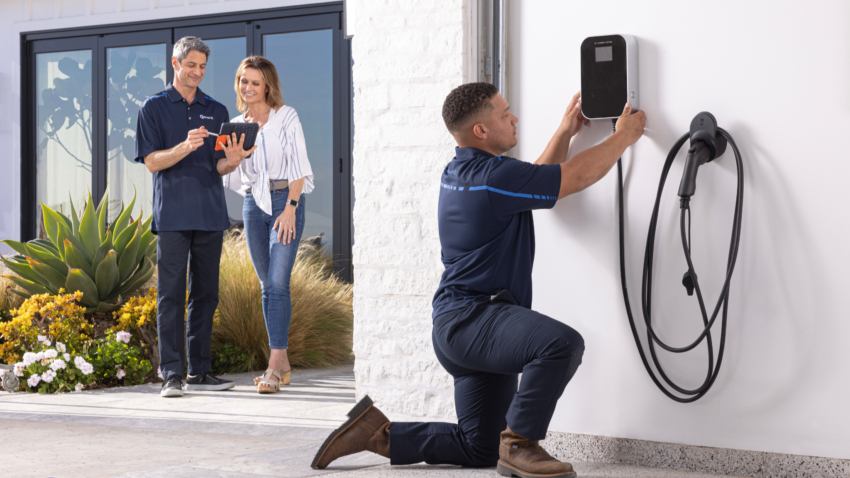
With the global electric car stock surpassing 5 million vehicles in 2018 and showing a 63% growth over 2017 (according to the International Energy Agency), the world has witnessed an undeniable surge in demand for electric vehicle chargers. The consequent challenge is how to install these chargers efficiently to meet this burgeoning demand and further expedite the mass adoption of EVs. The key here lies in observing the EV charger installations guidelines. This blog post explores different facets of efforts, based on these guidelines, geared towards optimizing and streamlining EV charger installations.
Understanding EV Charger Installations
To fully appreciate the drive to streamline this process, it is essential for you first to understand what an electric vehicle charger installation involves. Unlike gasoline refilling stations, where motorists stop for just a few minutes to refuel, electric vehicle charging requires dedicated home installations or dedicated charging stations. A typical installation encompasses proper site assessment, ensuring availability of requisite permits, wiring, equipment assembly and finally, system testing.
The Rising Demand for Ev Chargers
The rising number of EVs on our roads has translated into a heightened demand for EV chargers. This pressure is further amplified by the fact that most EVs have personal chargers installed at home. Such a trend reflects not only consumers’ preference for home-based charging due to its convenience but also the simultaneous need for public charging infrastructures ? a reality that underlines the urgency for streamlined installation processes.
Obstacles in EV Charger Installations
A plethora of challenges stand in the way of efficient EV charger installations. Among them are regulatory and permit-related barriers, deficiencies in installer training, and limitations associated with current electrical distribution infrastructure. Other pitfalls include the high costs of installation especially when heavy electric work is required at a site, lack of uniform standards, and the time-consuming nature of current installation processes.
Government’s Role in Streamlining Installations
Governments, particularly those keen on achieving their climate change goals, are ever more proactive in fostering efficiency in EV charger installations. Policy interventions range from offering incentives to homeowners to defray installation costs, introducing legislation aimed at accelerating the permit approval process, and funding training programs for electrical installers.
The Impact of Infrastructure
The existing electrical infrastructure ? or lack thereof ? significantly impacts the pace and scope of EV charger installations. Heavily-urbanized areas with robust electrical grids and established home wiring systems provide a conducive environment for rapid installations. However, installations can be particularly challenging in remote or less-developed areas where electrical infrastructure is either non-existent or underdeveloped.
The Role of Manufacturers
Manufacturers of EV chargers also play a crucial role in streamlining installations. Innovations such as compact designs and quick-setup features help simplify the installation process and save time. Further, manufacturers can aid by developing universal chargers compatible with different EVs, thereby reducing the complexity that comes with installing different chargers for varying vehicle models.
Standardization as a Key Strategy
One viable strategy to enhance the efficiency of EV charger installations lies in standardizing charging equipment. From connectors, power output ranges, to communication protocol, having uniform standards would alleviate the complexity of installing a plethora of different charger models. Moreover, standardization would make it easier for cities and municipalities to stipulate building codes that ease charger installations.
The Significance of Training
Competent installers are indispensable assets in creating efficiency in EV charger installations. In-depth training programs focused on equipping electrical engineers and technicians with the necessary knowledge required for EV charger installations are necessary. Such training programs should cover important aspects such as system design, installation procedures, troubleshooting, and maintenance.
How Technology is Simplifying Installations
Technological advancements have been critical in simplifying and hastening EV charger installations. The deployment of smart charg standardization have enabled faster and efficient installation processesions that can interact with utilities to manage electricity demand reduces the strain on our electrical infrastructure. Other technological leaps such as wireless charging, though still under research and development, offer promising possibilities for trouble-free installations in the future.
Pairing Renewable Energy with EV Charging Stations
Incorporating renewable energy sources like solar or wind in EV charging stations could circumvent some of the infrastructural issues that hamper speedy installations. Locations with limited access to grid electricity could greatly benefit from renewable energy-powered charging stations. Moreover, bringing in renewable energy also contributes to environmental sustainability ? a core driver behind the shift towards electric vehicles.
Futuristic Approaches: Smart Grid Systems
A futuristic approach set to revolutionize installation procedures is the concept of smart grid systems. These systems effectively monitor and manage power distribution, hence mitigating overloads in the power supply during peak charging times. Ultimately, they alleviate the need for major power infrastructural changes that may delay charger installations.
The Implications of Agile Installations
Efficient, streamlined charger installations have extensive implications for numerous parties. For electric vehicle manufacturers and consumers, faster charging system installations would mean quicker time-to-market and less wait time for customers. For governments and environmental groups, efficient installations would bring us closer to achieving our green goals more quickly.
Finding Efficiency
By understanding the factors influencing EV charger installation efficiency ? infrastructure availability, training, product standardization, regulatory input, technological advancements, and innovative approaches like renewable energy and smart grids ? you can better appreciate the concerted efforts towards streamlining these installations. Accelerated charger installations could very well be a determining factor in the mass adoption of EVs and the realization of a sustainable transportation future.